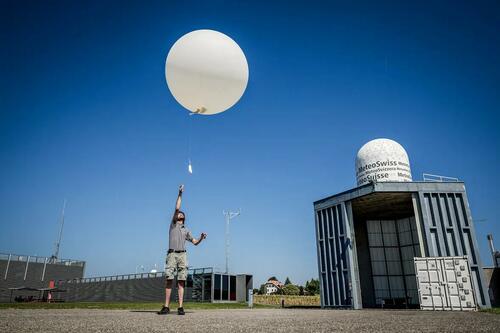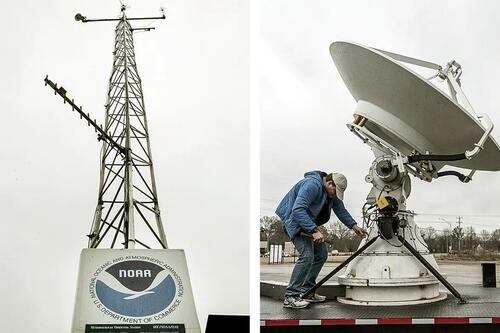Finally some push back concerning the climate!
No, it is not true that most scientists support the Global Warming theory. Most do not and those who do add huge caveats to their tepid support. We just do not know enough.
The models are inaccurate and replicate the past while saying almost nothing about the future. The data is just too complex for our understanding. The base in the 19th Century is too low, etc...
Still, do not expect a return to sanity any time soon. There is too much money and power grab hiding behind the curtain. The madness is not about to stop!
Authored by Alex Newman via The Epoch Times (emphasis ours),
Temperature records used by climate scientists and governments to build models that then forecast dangerous manmade global warming repercussions have serious problems and even corruption in the data, multiple scientists who have published recent studies on the issue told The Epoch Times.

The Biden administration leans on its latest National Climate Assessment report as evidence that global warming is accelerating because of human activities. The document states that human emissions of “greenhouse gases” such as carbon dioxide are dangerously warming the Earth.
The U.N. Intergovernmental Panel on Climate Change (IPCC) holds the same view, and its leaders are pushing major global policy changes in response.
But scientific experts from around the world in a variety of fields are pushing back. In peer-reviewed studies, they cite a wide range of flaws with the global temperature data used to reach the dire conclusions; they say it’s time to reexamine the whole narrative.
Problems with temperature data include a lack of geographically and historically representative data, contamination of the records by heat from urban areas, and corruption of the data introduced by a process known as “homogenization.”
The flaws are so significant that they make the temperature data—and the models based on it—essentially useless or worse, three independent scientists with the Center for Environmental Research and Earth Sciences (CERES) explained.
The experts said that when data corruption is considered, the alleged “climate crisis” supposedly caused by human activities disappears.
Instead, natural climate variability offers a much better explanation for what is being observed, they said.
Some experts told The Epoch Times that deliberate fraud appeared to be at work, while others suggested more innocent explanations.
But regardless of why the problems exist, the implications of the findings are hard to overstate.
With no climate crisis, the justification for trillions of dollars in government spending and costly changes in public policy to restrict carbon dioxide (CO2) emissions collapses, the scientists explained in a series of interviews about their research.
“For the last 35 years, the words of the IPCC have been taken to be gospel,” according to astrophysicist and CERES founder Willie Soon. Until recently, he was a researcher working with the Center for Astrophysics, Harvard & Smithsonian.
“And indeed, climate activism has become the new religion of the 21st century—heretics are not welcome and not allowed to ask questions,” Mr. Soon told The Epoch Times.
“But good science demands that scientists are encouraged to question the IPCC’s dogma. The supposed purity of the global temperature record is one of the most sacred dogmas of the IPCC.”
The latest U.S. government National Climate Assessment report states: “Human activities are changing the climate.
“The evidence for warming across multiple aspects of the Earth system is incontrovertible, and the science is unequivocal that increases in atmospheric greenhouse gases are driving many observed trends and changes.”
In particular, according to the report, this is because of human activities such as burning fossil fuels for transportation, energy, and agriculture.
Looking at timescales highlights major problems with this narrative, Mr. Soon said.
“When people ask about global warming or climate change, it is essential to ask, ‘Since when?’ The data shows that it has warmed since the 1970s, but that this followed a period of cooling from the 1940s,” he said.
While it is “definitely warmer” now than in the 19th century, Mr. Soon said that temperature proxy data show the 19th century “was exceptionally cold.”
“It was the end of a period that’s known as the Little Ice Age,” he said.
Data taken from rural temperature stations, ocean measurements, weather balloons, satellite measurements, and temperature proxies such as tree rings, glaciers, and lake sediments, “show that the climate has always changed,” Mr. Soon said.
“They show that the current climate outside of cities is not unusual,” he said, adding that heat from urban areas is improperly affecting the data.
“If we exclude the urban temperature data that only represents 3 percent of the planet, then we get a very different picture of the climate.”

Homogenization
One issue that scientists say is corrupting the data stems from an obscure process known as “homogenization.”
According to climate scientists working with governments and the U.N., the algorithms used for homogenization are designed to correct, as much as possible, various biases that might exist in the raw temperature data.
These biases include, among others, the relocation of temperature monitoring stations, changes in technology used to gather the data, or changes in the environment surrounding a thermometer that might impact its readings.
For instance, if a temperature station was originally placed in an empty field but that field has since been paved over to become a parking lot, the record would appear to show much hotter temperatures. As such, it would make sense to try to correct the data collected.
Virtually nobody argues against the need for some homogenization to control for various factors that may contaminate temperature data.
But a closer examination of the process as it now occurs reveals major concerns, Ronan Connolly, an independent scientist at CERES, said.
“While the scientific community has become addicted to blindly using these computer programs to fix the data biases, until recently nobody has bothered to look under the hood to see if the programs work when applied to real temperature data,” he told The Epoch Times.
Since the early 2000s, various governmental and intergovernmental organizations creating global temperature records have relied on computer programs to automatically adjust the data.
Mr. Soon, Mr. Connolly, and a team of scientists around the world spent years looking at the programs to determine how they worked and whether they were reliable.
One of the scientists involved in the analysis, Peter O’Neill, has been tracking and downloading the data daily from the National Oceanographic and Atmospheric Administration (NOAA) and its Global Historical Climatology Network since 2011.
He found that each day, NOAA applies different adjustments to the data.

“They use the same homogenization computer program and re-run it roughly every 24 hours,” Mr. Connolly said. “But each day, the homogenization adjustments that they calculate for each temperature record are different.”
This is “very bizarre,” he said.
“If the adjustments for a given weather station have any basis in reality, then we would expect the computer program to calculate the same adjustments every time. What we found is this is not what’s happening,” Mr. Connolly said.
These concerns are what first sparked the international investigation into the issue by Mr. Soon and his colleagues.
Because NOAA doesn’t maintain historical information on its weather stations, the CERES scientists reached out to European scientists who had been compiling the data for the stations that they oversee.
They found that just 17 percent of NOAA’s adjustments were consistently applied. And less than 20 percent of NOAA’s adjustments were clearly associated with a documented change to the station observations.
“When we looked under the hood, we found that there was a hamster running in a wheel instead of an engine,” Mr. Connolly said. “It seems that with these homogenization programs, it is a case where the cure is worse than the disease.”
A spokesman for NOAA’s National Centers for Environmental Information downplayed the significance, but said the agency was working to address the issues raised in the papers.
“NOAA uses the well-documented Pairwise Homogenization Algorithm every day on GHCNm (monthly)—version 4, and the results of specific adjustments to individual station series can differ from run to run,” the spokesman said, adding that the papers in question didn’t support the view that the concerns about the homogenization of the data made it useless or worse.
“NOAA is addressing the issues raised in both these papers in a future release of the GHCNm temperature dataset and its accompanying documentation.”



No comments:
Post a Comment